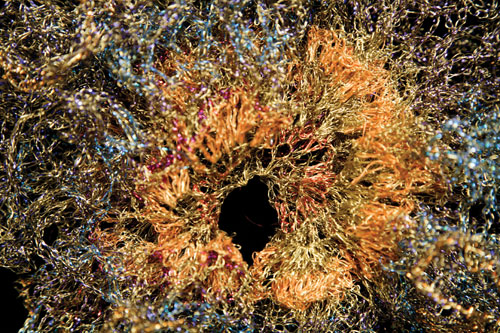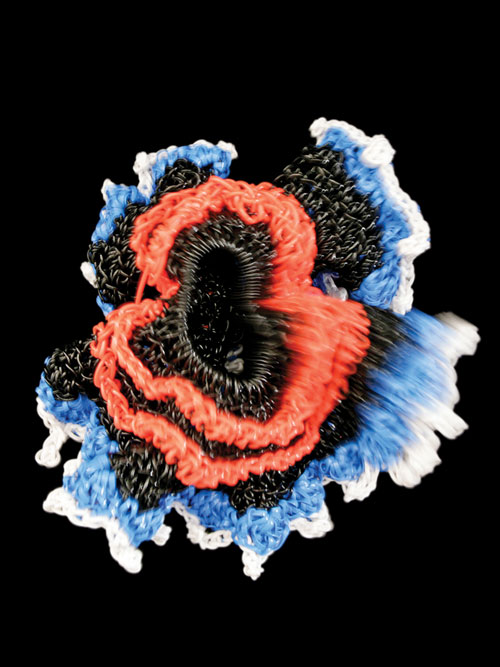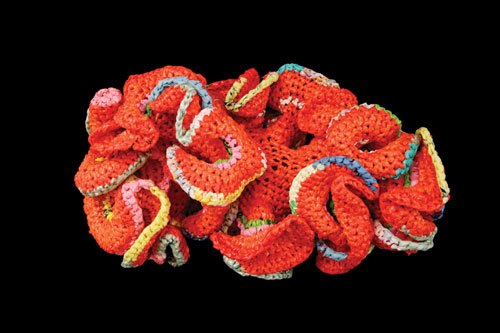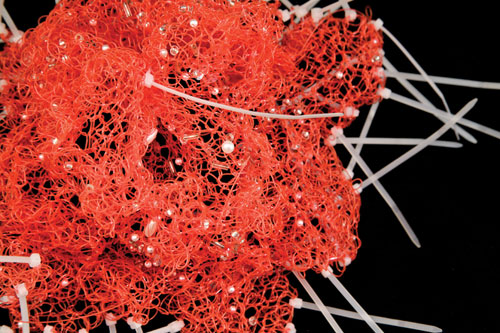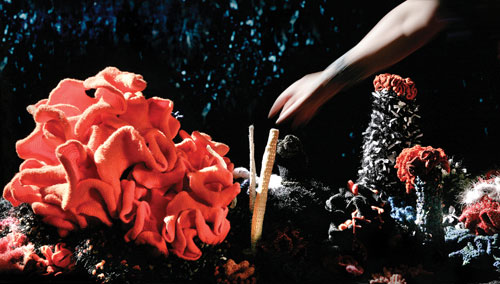
- One of the acknowledged wonders of the natural world, the Great Barrier Reef stretches along the coast of Queensland, Australia, in a riotous profusion of color and form—but global warming now threatens its future. In homage to these disappearing treasures, Australian sisters Margaret and Christine Wertheim instigated a project to crochet a handmade reef.
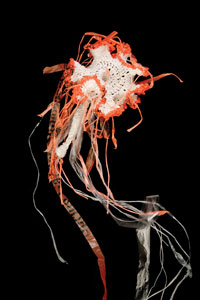
- The Bin-Liner Jellyfish Flock was made by Margaret Wertheim from the plastic bags that line waste baskets in offices the world over.
The more they’ve been shrinking, the bigger it’s been getting, though maybe that’s the wrong way to put it. The world’s great coral reefs, that is, and in particular Australia’s Great Barrier Reef, on the one hand—and, on the other, the Great Hyperbolic Crocheted Reef, brainspawn originally of a pair of Brisbane twins, transplanted to Los Angeles, alarmed at the harrowing fate of that beloved natural wonder and national treasure back home. For the Great Barrier Reef has, in fact, been dying off at a near precipitous rate of late—such that almost a third of its once magisterial 133,000 square miles (stretching out along 1,200 miles of the Queensland coast—the world’s largest organism, the first living structure visible to any craft approaching from outer space) has over the past couple decades been spiraling into collapse, a direct result, it now appears, of the rising ocean temperatures and sea acidification which are being occasioned (as predicted) by global climatic change. “The canary in the coalmine of global warming,” is how Margaret Wertheim, one of the twins, describes the status of all the world’s endangered reefs: a catastrophe that can no longer be dismissed as merely putative or hypothetical or looming, but one that is already well upon us, or so the shrinking reefs keep telling us, plain as day.
Which in turn makes the inspired provocation of Margaret and her sister Christine—this Hyperbolic Crochet Coral Reef—the AIDS Quilt, as it were, of global warming: a vast and growing act of witness; a remarkable amalgam of non-Euclidean mathematics, marine biology, evolutionary dynamics, environmentalist concern, feminine handicrafts, and good old-fashioned community activism; a dazzlingly colorful and ever-expanding marvel in its own right, somehow simultaneously as much an occasion for hushed wonder as a call for urgent action; a creation almost as vivid and pulsatingly alive as the reefs to whose perilous situation it so urgently seeks to draw attention. “I think the Great Barrier Reef represents to Australians what something like Yosemite or Yellowstone represent to Americans,” Margaret says. “It’s kind of this mythical place that we’re very aware we’re the custodians of. But in the last decade, reefs all over the world, and certainly the Great Barrier Reef, have suffered enormous devastation. So when we started the project in 2005 we were very specifically driven by an awareness that the Great Barrier Reef was being devastated, and we jokingly said to ourselves that if the reef ever disappeared, there’d be something to remember it by. But now, in 2011, scientists are seriously talking about the possibility.”
But let’s start, maybe, with that non- Euclidean angle, for that’s how the Reef itself first took root. Margaret, as it happens, is a physicist by training and a science writer by trade; her sister Christine is a former painter, now poet and professor at the California Institute of the Arts. Together several years back they founded the fetchingly titled Institute For Figuring with the intention of exploring and elaborating upon the aesthetic dimensions of mathematics and the sciences (figures, figures, figures—get it?). Margaret herself happened at the time to be following up on a book-length history of Western conceptions of space from antiquity through relativity, which of course had her delving into the story of Euclid and all the mathematics he was able to generate out of his famous five axioms— mathematics which seemed perfectly up to describing the entire world for the ensuing two thousand years, until the early nineteenth century when a series of geometrists began to suspect the efficacy of Euclid’s fifth axiom— the one that asserts that on any given surface if you have a straight line and a point outside that line, there is one and only one line that can go through that outer point and not intersect the first line (the so-called parallel postulate). First Gauss and then Lobachevsky and Bolyai and presently Riemann and Hilbert all began saying, effectively, “Oh, yeah, what about this line and this line and this line?” (abstractly, algebraically understood)—in fact one could envision a coherent mathematics in which infinite lines passed through that first point without intersecting that line (and it’s a very fertile field of mathematics at that, one that eventually spawned everything from the theory of relativity to much of the infrastructure of the Web).

- Crochet coral and anemone garden with urchins by Christine Wertheim and sea slug by Marianne Midelburg.
The only problem is, it’s damnably difficult to envision, let alone realize, the precise sort of surface any such mathematics could actually be operating on. Mathematicians during the nineteenth and into the twentieth century famously drove themselves crazy—in some cases, literally so—trying to do so. That is until about twenty years ago when (long story, expertly conveyed on the Institute For Figuring’s website at theiff. org) a Latvian émigré mathematician named Daina Taimina teaching at Cornell heard about the problem from her geometer husband and effectively said, “What’s the big deal? You can crochet such a surface.” And, drawing on the women’s handicraft traditions of her childhood, she proceeded to do just that. (Such is the cost of having had so few women mathematicians until relatively recently.) Continuing to research her book a few years later, Margaret visited Taimina and returning home began crocheting up a storm, along with her sister. Whereupon gazing upon their production one fine morning, Christine declared, “Wait a second, this is starting to look just like a coral reef, we could crochet a coral reef!” (Indeed, as they both suddenly realized, coral reefs had been generating hyperbolic non-Euclidean forms since time immemorial. As Margaret says, “All the frilly crenulated structures that you see in coral reef organisms are actually biological manifestations of hyperbolic geometry.” Such is, perhaps, the historic cost of not consulting brain corals for the solutions to complex math problems.)
“Somehow one suspects that the Reef is notd finished, probably not with the Wertheims and certainly not with the rest of us. Organically it just seems to grow and grow.”
The sisters sent out word that they were embarking on a project to crochet a coral reef and posted rudimentary guidelines on their website. Soon others began joining in—women (largely women) from throughout the world. A few months later, the infant reef made its first public appearance at the Andy Warhol Museum in Pittsburgh as part of an artists-confrontingglobal- warming show. Visitors would gaze awestruck into the aquarium vitrine, and you could see many of the women—miming away, intently working out the necessary crocheting moves with their fingers—as almost magically, the reef seemed to cast off polyps of inspiration. Prior to the reef’s next appearance, in Chicago, the sisters held a series of community workshops in which they couched practical instruction with mathematical background, biological insight, feminist implication, and ecological alarm. (One of the fascinating things about the whole exercise is how easily it seems to leapfrog class divides: Southside gospel groups were beavering away, every bit as enthusiastically as Lakeshore rich-lady knitting klatches; entire classrooms full of pre-teenagers threw themselves into the game; and everywhere, individuals who’d hardly given global warming any thought were suddenly becoming ardently engaged.) By the time the main reef arrived in Chicago, an entirely new Chicago reef was there to join it. Classfuls of kids would come visit it on field trip outings, gleefully sluicing about like schools of tropical fish. And the same each further time out, only ever more so, as the reef presently visited New York, Los Angeles, Sydney, London, and Dublin, alighting this past winter in the Sant Ocean Hall of the Smithsonian’s National Museum of Natural History in Washington DC.
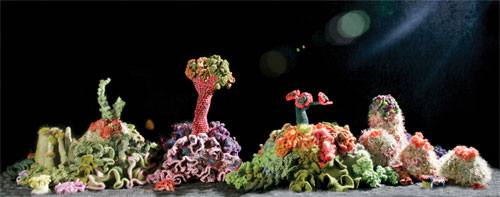
- Definitively referencing the domestic roots of handicraft, the Ladies Silurian Atoll was made by a small and intimate group of the Reef’s most dedicated contributors. This delicate “fancywork” marvel evolved within the private space of Margaret and Christine’s living room.

- Made from the blue plastic wrappers of the New York Times, embellished with straws and medical waste, the Blue Grove is the creation of Los Angeles librarian Clare O’Callaghan, who has been collecting plastic trash for over thirty years.
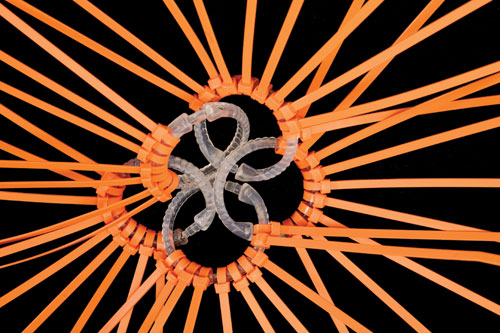
- Plastic diatom form made from plastic shower curtain rings and cable ties by Dallas contributor Evelyn Hardin.
The Wertheim twins meanwhile were becoming ever more engaged by a sort of parallel ecological peril, known as the Great Pacific Garbage Patch: an area about twice the size of Texas, several hundred miles north of Hawaii, where the ocean’s currents converge in a great gyre, delivering all the stray plastic washing off the coasts of California, Canada, Alaska, Russia, and Japan—a vast now largely lifeless expanse thirty meters thick with bobbing, deadly trash. In order to call attention to that peril, the twins peeled off a whole separate section of their Hyperbolic project, an ever bourgeoning Toxic Reef, fashioned entirely out of plastic: castoff soda bottles, unspooled tape cassettes, shredded grocery bags, and the like. And once again, craftswomen throughout the world proved ever more creative in answering the call.

- The Bleached Bone Reef features works by some of the project’s most technically skilled crafters, including beaded sea creatures by Nadia Stevens, Jill Schreier, Pamela Styles, and Vonda N. McIntyre.
So, too, they have created two sections of the reef that invoke stages of so-called coral bleaching— a consequence of escalating atmospheric carbon dioxide, which in turn causes seawater to acidify (a phenomenon sometimes described as “Coca-Cola ocean”). Thriving corals derive their signature kaleidoscope of color from flagellate protozoa called zooxanthellae. “The sign that corals are stressed,” Margaret says, “is that they begin to lose their color; they expel their zooxanthellae.” Without their photosynthesizing guests, the corals turn to ghostly skeletons. “If the conditions return to healthiness,” she says, “the zooxanthellae come back, and the corals regain their color. But if the conditions don’t return to healthiness, the corals die and eventually become bone white.”
This past summer the Reef came back home to Pasadena for a spectacular summary exhibition at the Alyce de Roulet Williamson Gallery at Art Center College of Design. After that, who knows? In part the past several years have been a story of the Reef that Ate the Twins. And they keep saying how they have at some point to get out from under it and to return to their previously scheduled lives. But somehow one suspects that the Reef is not finished, probably not with them and certainly not with the rest of us. Organically it just seems to grow and grow. As all the while its real world referents continue, alas, to shrink and shrink.







